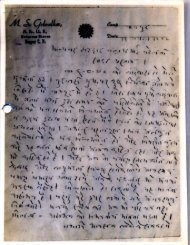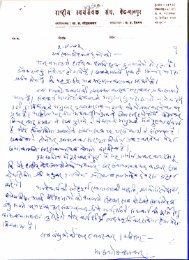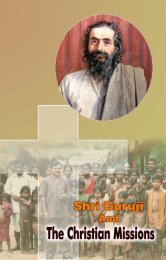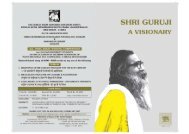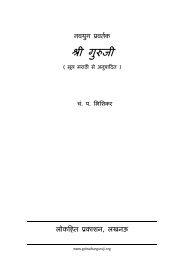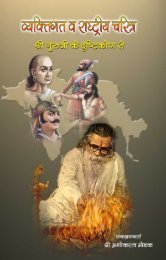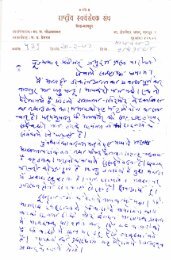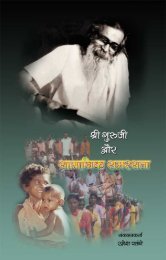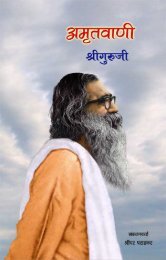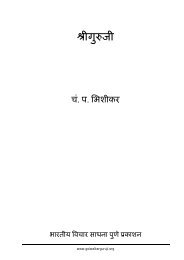Shri Guruji and Indian Muslim.pdf - Shri Golwalkar Guruji
Shri Guruji and Indian Muslim.pdf - Shri Golwalkar Guruji
Shri Guruji and Indian Muslim.pdf - Shri Golwalkar Guruji
You also want an ePaper? Increase the reach of your titles
YUMPU automatically turns print PDFs into web optimized ePapers that Google loves.
Chapter - VI<br />
Concept of minority<br />
The biggest absurdity of <strong>Indian</strong> secularism is legitimacy to the concept of minority. The<br />
classification of the people on the basis of mode of worship <strong>and</strong> its application in the<br />
principle of governance militates against our own historical experiences. <strong>Guruji</strong> says,<br />
‘History bears testimony to the fact that Bharat, the cradle l<strong>and</strong> of religious generosity has<br />
always welcomed <strong>and</strong> assured all religious groups a free, honourable <strong>and</strong> secure<br />
life.”(G2000: 321) He further argues that in India there is ‘no question of majority <strong>and</strong><br />
minority.”(<strong>Guruji</strong>: 1986:12) His submission has again <strong>and</strong> again been attacked by the<br />
secularists (Red-Green club) as anti <strong>Muslim</strong> tirade. For decades both <strong>Guruji</strong> <strong>and</strong> his critics<br />
ceaselessly made their respective proposition. And the <strong>Indian</strong> judiciary finally endorsed<br />
<strong>Guruji</strong>. The Supreme Court of India in a l<strong>and</strong>mark<br />
Judgement on August 10, 2005 said that the National Commission for Minority (NCM)<br />
“should suggest ways <strong>and</strong> means to help create social conditions where the list of notified<br />
minorities is gradually reduced <strong>and</strong> done away altogether.” 22 Moreover three-member bench<br />
of the Court consisting of Justice R. C. Lahoti, Justice D. M. Dharmadhikari <strong>and</strong> Justice P. K.<br />
Balasubramanyam gave their equally important observation, “The objective of a democratic<br />
society ought to be to eliminate majority <strong>and</strong> minority…” 23<br />
<strong>Shri</strong> <strong>Guruji</strong>’s perception <strong>and</strong> articulation had many votaries in the<br />
22 <strong>Indian</strong> Express, August 11, 2005<br />
23 <strong>Indian</strong> Express, August 11,2005<br />
Constituent Assembly. Dr. H. C. Mookerjee, vice chairman of the Assembly <strong>and</strong> Christian by<br />
faith on May 25, 1947, raised two fundamental questions before the Assembly, ‘the first is,<br />
are we really honest when we say that we are seeking to establish a secular state? And the<br />
second is, whether we intend to have one nation? If our idea is to have a secular state it<br />
follows inevitably that we can not afford to recognise minorities based upon religion.”(CA<br />
Debates, Vol. VIII, P298)<br />
<strong>Guruji</strong> rightly pointed out that “ while bringing about integration with the nation in its<br />
practical life, destruction of distinct ways of worship is not aimed at, only putting an end to<br />
undesirable tendencies of exclusiveness <strong>and</strong> intolerance is aimed at;”(G 2000:168)<br />
Concept of Mother India<br />
<strong>Guruji</strong> treats the nationality above religious <strong>and</strong> all other identities <strong>and</strong> consistent to<br />
<strong>Indian</strong> tradition he elevates the nation as a Mother <strong>and</strong> above all goddess to be worshipped.<br />
The concept of Motherl<strong>and</strong> is a common point of assimilation of <strong>Muslim</strong>s with the culture. It<br />
is the supreme religion. However, it is not idolatry in a religious sense or merely ritual to<br />
worship the symbol of the Mother India but it is identification with the nation. Such<br />
dedication is not meant to create any totalitarian state or expansionist mission. It establishes<br />
an organic link between the people <strong>and</strong> the l<strong>and</strong> <strong>and</strong> its culture <strong>and</strong> history. He defines the<br />
nation as “a practical <strong>and</strong> physical manifestation of the culture <strong>and</strong> a set of values, samskars,<br />
inherited by the people inhabiting in a geographical boundary.”(<strong>Guruji</strong>: 1997:21) He further<br />
underlines the importance of the motherl<strong>and</strong> in the Hindu tradition. He observes, “In our<br />
concept of nationality some elements have been emphasised. Abounding reverence for the<br />
Motherl<strong>and</strong> is placed at the top. Then comes in order the respect for our history, which of




